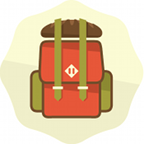While we hadn’t planned on taking such a long time off from writing, we’ve been unlucky in Internets for the past few weeks. And tonight we board our transatlantic cruise for home*, so we won’t have access to the internet again until we get back on November 12.
You’re right: that does sound like the very worst.
But when we get back, we’ll have all sorts of things to tell you–things about Italy and southern France (a redemptory experience, after the disappointments of Paris), things about taking cruises (and how we’re pretty sure we’ll never do this again)… so many things to look forward to! So just hold on, pals, and so sorry about the delay!
In the meantime, Matt and I have pulled together PART ONE of a multi-part Best of Europe series, in which we compile a list of our favorite places/experiences/moments in Europe. So to tide you over until proper posts…
BEST OF EUROPE, PART 1 : FOOD & DRINK
Favorite street food
Matt: fried seafood in a paper cone (Cinque Terre, Italy)
Bri: pierogi (Krakow, Poland)
Favorite local speciality
Matt: gelato (Italy)
Bri: pesto (Cinque Terre, Italy)
City with the best grocery store
Matt: Lucca, Italy
Bri: Berlin, Germany
Best country for local wine
Both: Italy (red), Austria (white)
We have to note, however, that we were delighted to learn that Slovenia has some killer whites as well. Slovenia is amazing for a number of reasons, but we didn’t expect to count wine among them–happy to learn something new there.
Country with best beers
Both: Belgium
Best meal cooked using only a hot plate
Matt: carbonara
Bri: breakfast hash
Note that these two meals consist of pretty much the same ingredients: bacon, egg, cheese, onion, and either pasta or potatoes. But when we had particularly sad kitchens containing nothing but a single hot plate, having these recipes in our back pocket saved us. Especially when we were on that farm in Iceland, 50 minutes away from the nearest restaurant.
Favorite food-related cultural practice
Matt: coffee and pastry culture (Vienna)
Bri: high tea (England)
Country with strangest local food
Both: Germany
Matt ordered a sausage salad while in Augsburg, expecting that there would be sausage on top of a regular salad. But no–the salad was MADE OF sausage. It was delicious, yes, but totally weird. So well done, Germany, you delightful lunatics.
Best hot beverages
Matt: everywhere in Italy (coffee)
Bri: Aix-en-Provence (hot chocolate)
Favorite pub
Matt: The Bear (Bath, England)
Bri: Szimpla (Budapest, Hungary)
Favorite dining experience in an actual restaurant
Both: Mini, Vienna
It was our anniversary, and the food/staff was INCREDIBLE. Possibly the best food we had anywhere all trip.
Okay, that’s all for now. We’ll write a proper post or two while we’re trapped (yes, trapped) on the boat this week, and then post as soon as we get back in the good ole US of A. Not too long now, kiddos! See you soon!
* We’re taking a cruise, by the way, because it was cheaper than taking a flight home. We’re generally not the “oh, dahling, we simply must cruise home!” types, but we are definitely the “LOOK AT THAT AMAZING DEAL” types. So here we are. Full of regret and desserts.









